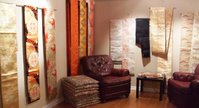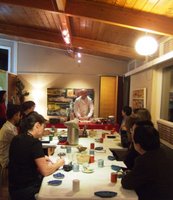
 Walls of Gold and Silk
Walls of Gold and SilkStepping Stones
Art Gallery
January 2007
The Beauty
of Japanese Tapestry: The OBIPhotos at right: Over two dozen of the Camellia Teas of Ottawa Private Collection are on display during January 2007. Special Thanks to Ms. Seifu Ogawa who donated two kimono calendars for this exhibition.To view the Exhibition Catalogue, click here: Walls of Gold and SilkCurator’s Introduction (Rebecca Benoit)
Why the fascination with the Obi?In 1998, I first was introduced to the marvelous world of Japanese textiles through the obi.
The gorgeous patterns and brocades of gold and silk soon became a passion and before I knew it, my collection had grown to dozens of these incredible treasures.
It wasn’t until 2004 when I began my formal study of Kimono dressing with the Sodo School and competed nationally in the Ms. Universe Kimono Contest that I finally learned to tie them on myself. By then, I had fallen in love with the obi and was determined to share this incredible treasure with Canadians.
The main function of this exhibition is to help visitors gain an understanding of the art of kimono dressing, an appreciation for the beauty, functionality and artistry of obi-tying and to situate the kimono’s place within the Japanese Tea Ceremony.
It is a great pleasure to present to visitors this modest collection of the Stepping Stones Art Gallery’s Permanent Collection.
***********
 Brief History of the Obi1963. Minnich, Helen Benton and Nomura, Shojiro. Japanese Costume and the Makers of its elegant tradition. Tokyo: Tuttle Press. Excerpted from Appendix Five “The Evolution of the Obi”, pp 351-353.
Brief History of the Obi1963. Minnich, Helen Benton and Nomura, Shojiro. Japanese Costume and the Makers of its elegant tradition. Tokyo: Tuttle Press. Excerpted from Appendix Five “The Evolution of the Obi”, pp 351-353.The evolution of the obi, the most important and often most costly accessory of Japanese dress, especially that of women, deserves a chronological review. In the early periods, although there were many scarves and sashes and streamers, the “belt” was more or less a part of the top fastening of the hakama. Although there is frequent mention of its elaborate decoration, it must have been almost hidden by the many layers of kimono worn above it.Since the early 13th century, however, its evolution is fairly easy to trace through literary and pictorial references. In the late 13th Century, some wore obis of linen, two or three inches wide, tied in front with short hanging ends. This was probably the prevailing fashion of the time, and it is seen in paintings as late as the end of the 16th century.
Did you know?The Obi in its current form is a result of the Great Meireki Furisode Fire in Tokyo in 1657 and another in 1661.. During the fires, the shorter, thinner obis of the time came open and fell off as people were running. After that time, the obis were thicker, longer and wider: and much more secure!The evolution of the ObiFrom 1334 to 1572 (Muromachi Era), silk was the more commonly-used material.
From 1573 – 1602 (Azuchi-Momoyama Era), obi were still ribbon-like, although a trifle wider. They were most frequently of silk woven in conventional patterns such as plaids and checks. Those of court ladies, however, were often of heavy silk woven in gold floral designs against a black background and were about two inches wide.
Stiffened with a paper lining, these were not tied, but had the ends simply tucked in at one side. Such were the obi that legend says so easily came untied in flight from the great fires in 1657 (in which 100,000 died in 2-3 days and decimated 60% of Tokyo at the time) and again 1661.
Did you know?
…Of the 1,500 estimated Japanese here in Ottawa, to my knowledge, only one is capable of tying the obi in a variety of advanced, highly complicated knots! Ms. Yuki Kurimoto studied kimono dressing for only one year, and advanced quickly! For those interested in Kimono study, we hold workshops from time to time. Contact R. Benoit for more details.Among courtesans of Hideyoshi’s time there was a fashion that copied the rope belts worn by Chinese artisans working in the vicinity of Nagoya in Kyushu Province. Popularized as the Nagoya obi, it was simply a cord tied three or four times around the waist with long ends hanging down in front. But the fashion was never copied by gentlewomen of the Samurai or Aristocracy.In the early Edo period (1603 to1868), possibly as a result of the great fires, obi were more securely put on and became increasingly intricate in their tying and elaborate in their material, until in the mid-17th C, and subsequently, the variations were virtually unlimited.
Did you know?
…The Great Fires in Tokyo in 1657 and 1661 also placed huge pressure on the Kimono market in Kyoto! Thousands had lost their clothing and needed instant replacement. Thus, a simpler form and design of kimono and obi came onto the market to meet this huge demand.Even before the fires, courtesans tied their still narrow obi in front, and the fashion was widely copied in Kyoto then and later, except by Samurai ladies. After the fires nearly all obi were tied on one side in a butterfly knot, and soon they were made of much wider material. An ordinary width was cut in two, then doubled lengthwise to about seven, and later eight, inches.
Did you know?…The average obi is over 10-12 feet long (3-4 m) and often costs several thousand dollars…Throughout most of the Edo period, the obi enjoyed the widest possible fashion latitude in material, size, and manner of tying, until it became virtually standardized in the two styles we have known in the 20th century. Brides and young girls may wear a big butterfly bow set either at an angle or straight across the back, but married women always tie theirs in a very complicated flat drum knot behind.
To the uninitiated, the tying of the obi is so complicated that many young girls now use clip-on types.
Great expense and beauty of design are still lavished on the materials, however; stiff brocade for dress occasions and a softer patterned silk for more informal wear. The piece is woven about a foot wide and about 12 feet long.
Did you know?…Inside the obi, a small cushion is hidden to give it volume and at least 1 – 3 cords are used to keep it in place. The central narrow cord (called the obi-jime), is also hand-woven of silk. Tying the Obi
The obi is folded in half lengthwise as it is wound firmly around the waist, the two selvages are turned up to afford a convenient pocket for a small purse, a handkerchief, or cosmetics. One end left over at the back is about two feet long, the other more than twice that length. These two are tied into an intricate and, to most of us, incomprehensible knot which is bolstered out with a small pillow (called the ‘obi-makura’). Knot and pillow are each held in place by its own narrow silk cord (obi-jime). This cord that passes through the knot is fastened in front and occasionally a delicate brooch called the obi-dome (brooch) is attached.
Did you know?…There are literally thousands of ways for a woman to tie her obi! As part of graduation, each kimono student must develop a completely new and unique knot and name it. A man’s obi is much simpler. For everyday wear it is made of wide soft silk, about four inches wide and simply tied in a double knot behind and is comparatively easy to tie and comfortable to wear. Compared to women, men have only 3 or 4 ways of tying their obis.
Remember! Left over right!Two stories:For the living, the kimono is always closed left over right. Only the dead are clothed in kimono right over left.Another reason is that the Samurai, who had to wear their katana (sword) on their left side. When pulled with their right therefore, it never got caught in the kimono folds.******************
Frequently Asked Questions about Kimono and obi
An interview with R. Benoit and M. Mizuno
Ms. Michiko Mizuno studied the Sagami School of Kimono Dressing in Japan for two years and continues her practice in Ottawa today. Rebecca Benoit studied the Sogo School of Kimono dressing and competed nationally in 2005.R: How many Japanese women today can dress themselves in kimono (on average)?M: It’s difficult to get a precise estimate, but likely less than 1% of the population as there are few opportunities to wear kimono today.
R: How often would the average woman wear a kimono then?M: Likely only once, for very special occasions, a few times in their lives.
R: Can you give me an example of these events?M: Certainly, for example young girls might visit a Shinto Shrine when they are three and seven years old at a November Festival for children. Later, when they turn 20, if their parents can afford the several thousand dollars needed to buy a long-sleeved kimono and all the necessary accessories, they would wear that at Coming of Age day in mid-January. Finally, many young Japanese women today no longer even wear a kimono on their wedding day, because they prefer the white western dress instead. Thus, the chances for the average woman to wear a kimono today are very, very few.
R: Thank you, Michiko. Given that there are so few chances to wear a kimono, I imagine that very few people are capable of dressing themselves. What do they do?M: Well, they have two options. First, they can study once a week, for six months to one year to be able to dress themselves, investing a few thousand dollars in their training. For those who continue their kimono studies, they would specialize in being able to dress others and more advanced techniques of obi-tying. Alternatively, for those unwilling to spend this time, they can pay about $200CAD to be dressed on single occasions.
R: My goodness! That sounds like quite a business for kimono dressers!M: It may seem like quite a bit, but if you remember that there are few chances to wear kimono today, not many professional kimono dressers are able to make their living this way. Some hairdressers study kimono dressing to supplement their income and add to their professional skill set. Most of their clients will request having their hair done for kimono and to be dressed at the same time, so it’s a practical side business.
R:. It is quite a common myth that kimono are only worn by Geisha. What are your thoughts on this?M: Yes, it is a myth indeed. All sorts of women wear kimono.
The movie, Memoirs of a Geisha was both good and bad for the image of the kimono. In fact, this movie was not even entitled Geisha in Japan, but rather ‘Sayuri’ (the name of the main character) due to the huge outcry about this movie’s portrayal of Japan’s ‘Art-Practitioners’ or Geisha. The truth is that the women you see with white painted faces are NOT usually Geisha. These are MAIKO, apprentice Geisha and they dress in this manner only while they are studying. You can identify them easily by their cascading obi (it hangs down the back). Once they graduate and become GEISHA, they don’t always wear the white makeup, elaborate hair or fancy kimono. The reason they dress this way, when they are young, is to make up for their artistic shortcomings by at least appearing beautiful or lovely. The true GEISHA is so skilled, so talented in a wide variety of artforms that she does not need to ornament herself as the young MAIKO must.
R: I’m often asked, as the owner of a rather large kimono and obi collection, where these can be bought in Canada, and how much they cost. What can you tell us about this?M: I’m amazed by your collection! Our Camellia Teas of Ottawa Group appreciates being able to borrow them for our monthly Tea Ceremony events. It is extremely unusual to have so many, but perhaps even more so, to share them so openly.
R: Thank you so much. They are so lovely it’s tough not to collect them! When I was in Japan, I would go to the famous Toji Antique Market Temple in Kyoto on the 1st Sunday and 21st of each month. Often I could find great deals – such as 3 kimono for $10.00 CAD! Obis were always rather expensive, but it is possible to buy antique kimono at a reasonable price.
(See http://www.kyotoguide.com/)M: True. But most Japanese hesitate to wear used kimono. Although it’s common for kimono to be passed down from mother to daughter, we don’t tend to buy them from others. The truth is, buying a brand-new kimono costs thousands of dollars! The kimono is several thousand, rightly so, as it takes months to weave and dye the fabric and then to sew it into the proper form. The obi also costs thousands of dollars and takes months to weave. The threads used are real gold and silver, with heavy silk brocade. Then the underlayers and sashes etc. often cost hundreds of dollars. In all, the kimono costs well upwards of two or three thousand dollars CAD. A very expensive gift to request from the next person traveling to Japan!
R: Exactly! So let’s make sure that everyone knows where to find a great deal on this exquisite national costumes of Japan! We encourage you to visit Kyoto on the 1st Sunday and/or the 21st of each month and enjoy shopping at Toji Temple! Thank you Michiko-san. M: It has been a pleasure to introduce the obi and kimono to the guests of the Stepping Stones Art Gallery. It has truly been a pleasure to work with Ms. Yuki Kurimoto to tie obis and display them here for all.
















